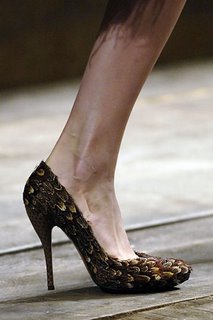
Getting a Master's degree in fashion history can ruin you for contemporary fashion. I get to examine and sometimes even touch clothing of unimaginable beauty, innovation and exquisite
quality the likes of which are rarely seen today even in the
haute couture. I also get to see garments in their first incarnation, instead of yet another contemporary design re-hashing (okay copying) designs from the past. I get to see original Vionnet bias-cut satin evening dresses from the 1930s instead of say Ralph Lauren’s re-interpretation of them. And nothing can compare to vintage textiles. The feel or hand of a Balenciaga silk cannot be beat. 1930s silk-chiffon backed velvet? Heaven! I want bed sheets made of it. Quite literally, textiles like those just aren’t made anymore.
But don’t get me wrong, even though I can be a bit of a fashion nerd (um who really lengthened hemlines in the late 1920s first, Lelong or Louiseboulanger?), I love, love, love contemporary fashion. Clothes are: transformative, mysterious, exclusionary, democratizing, fun and a cheerful antidote to New York City’s grey winter days. What a wonderful cultural product clothes are! They represent the
zeitgeist and everyone participates just by wearing them!
As a cultural product why is good fashion criticism so meager? Criticism is not the same thing as reportage or trend spotting. Cathy and Suzy sometimes delve into it for a sentence or two, but never go too much in depth. Amy Spindler attempted and I wonder how her career would have progressed should she have lived. I wish
The New Yorker still had fashion critics like Lois Long back in the 1920s and 30s or even Kennedy Fraser in the 1970s. It would be nice to have serious articles more than once a year. Shouldn’t fashion be criticized like other cultural disciplines such as art, theatre, film, and even television? I’m not a dour fashion dictator who thinks that fashion has to be so damn
serious all the time, because it can be/is often light-hearted and whimsical (hello Elsa Schiaparelli), but placing fashion within its cultural context is important. I want to know more about Galliano’s historicizing fashion spectacles than just that they’re over-the-top and not so successful every go round. Why?!
So in the spirit of figuring out the why’s and the what’s, a blog seemed a good place to start.
Hello.












